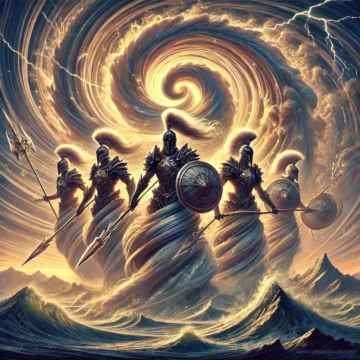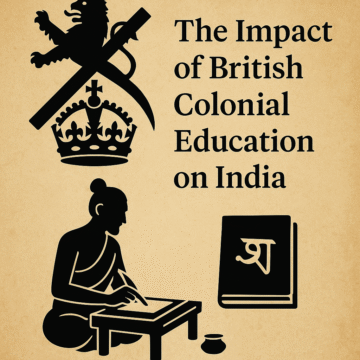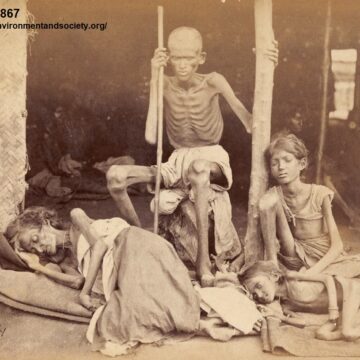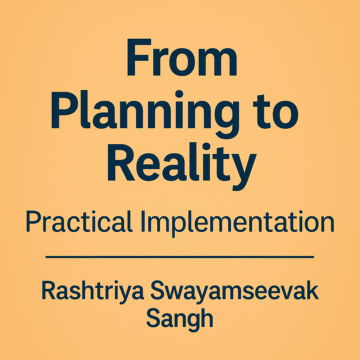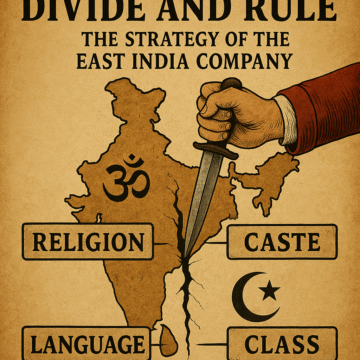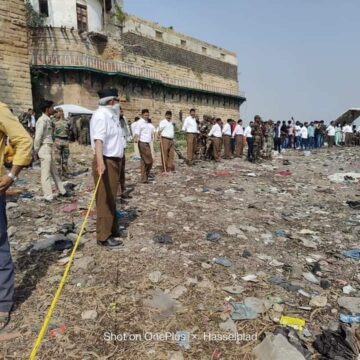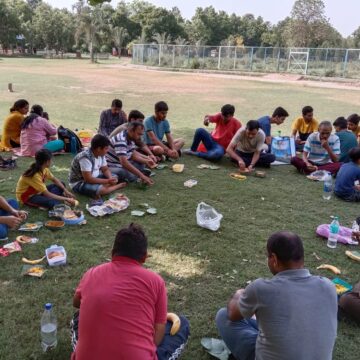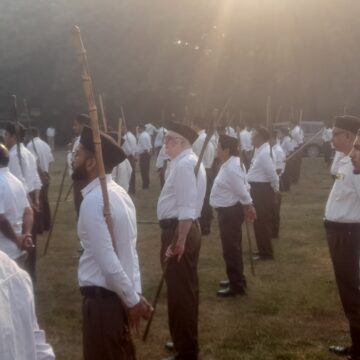The Rigvedic hymn 1.64 presents the Maruts as a unified storm-host embodying the protective power of ṛta. Far from mere poetic embellishment, traditional and modern commentaries show the Maruts functioning as guardians of order who remove obstacles, strengthen communities, support rightful authority, and provide the inner resilience needed for civilizational continuity and collective defense.
Category: Bharat
Cultural Genocide by British: India’s Civilizational Soul Destroyed
British rule in India was more than economic exploitation—it was cultural genocide. Through Macaulay’s education policy, caste codification, missionary propaganda, and historical distortion, the British dismantled India’s civilizational memory. This blog uncovers how they replaced Gurukuls with colonial schools, suppressed Ayurveda, and divided society—leaving a legacy of mental colonization that still lingers.
British Loot and Industrialize: How India Funded Britain’s Rise
Britain’s Industrial Revolution didn’t emerge from innovation alone—it was bankrolled by India’s wealth. From Bengal’s Diwani revenues to opium trade and cotton extraction, British industry rose on Indian poverty. This blog exposes the $45 trillion drain that built modern Britain while deindustrializing Bharat—an economic heist masked as civilization.
Future Vision: Path of the Coming Century
The RSS Centenary Sankalp Patra outlines a Future Vision for the next century, balancing tradition and modernity. From institutional growth and social transformation to global leadership, diaspora roles, AI ethics, education, Ayurveda, and cultural revival, the roadmap emphasizes dharma-based life, harmony, and world welfare. It envisions India as a moral, cultural, and spiritual guide.
Vasudhaiva Kutumbakam: Indian Vision for Global Welfare
The RSS centenary Sankalp Patra reaffirms Vasudhaiva Kutumbakam: the whole world as one family. From spiritual roots in Sanatana Dharma to practical visions for peace, justice, environment, economy, and culture, this vision contrasts with Western globalization by emphasizing harmony, cooperation, and universal brotherhood. It is not dominance, but India’s civilizational duty of sharing.
Bengal Famine and British Genocides: How Colonial Policies Killed Millions
Between 1765 and 1947, British rule caused twelve major famines that killed an estimated 30–60 million Indians. These were not natural calamities but deliberate policy outcomes—tax rigidity, grain exports, and racist governance that turned droughts into genocides. The blog exposes how colonial profit replaced compassion, making famine Britain’s deadliest legacy in India.
From Planning to Reality: RSS’ Practical Implementation
The blog From Planning to Reality: Practical Implementation explores how the Rashtriya Swayamsevak Sangh translates resolutions into action. It covers branch expansion, training, leadership development, institutional building, harmony, and technology, showing how clarity, discipline, and evaluation transform vision into tangible social change. This journey reflects the Sangh’s century-long experience of turning commitments into reality.
British Stole Indian Treasures: Colonial Plunder and Cultural Genocide
Britain’s colonial conquest of India was not only political but civilizational. Millions in wealth, sacred art, and knowledge were stripped from Bharat—Tipu Sultan’s treasures, Amaravati Marbles, Kohinoor Diamond, and ancient manuscripts now fill British museums. This plunder erased India’s cultural memory and redefined its heritage as imperial trophies—a crime whose echoes still resonate today.
From Struggle to Solution: Facing Modern Challenges
Modern challenges span from information wars and judicial bias to environmental crises and cultural disintegration. The RSS centenary declaration reaffirms that solutions must rest on dharmic strength and national unity. By combining adaptation, innovation, and cooperation, Bharat can move from struggle to solution while offering the world a vision of harmony and resilience.
Divide and Rule by East India Company
The British didn’t conquer India by force alone—they conquered it through division. Divide and Rule by East India Company reveals how religion, caste, region, and class were systematically weaponized to keep Bharat fragmented. From Plassey to Partition, it exposes how a civilizational mosaic was turned into a map of conflict and dependency.
Spiritual Foundation: Power of Sarve Bhavantu Sukhinah
The centenary declaration of RSS makes clear that every program—shakha expansion, leadership, social change—rests on a deeper spiritual foundation. Expressed in the timeless prayer Sarve Bhavantu Sukhinah, this foundation guides individuals from self-discipline to world peace. It is not limited to ritual but extends into families, society, and Bharat’s global responsibility.
Panch Parivartan: The Five-Dimensional Transformation
Panch Parivartan represents the most comprehensive goal of the RSS Centenary Declaration—five layers of transformation from the self to the world. It begins with individual discipline, extends into family values, social harmony, and national strength, and culminates in global welfare. This five-dimensional model weaves unity, prosperity, and spirituality into one continuous process of renewal.
Social Metamorphosis: From Values to Culture
Social Metamorphosis: From Values to Culture is not just about reform, but a holistic transformation of society. It begins with individuals shaped by values, extends into families, education, and communities, and balances economic strength with cultural revival. Women, youth, technology, and even the global Hindu diaspora together create a living model of harmony and collective progress.
Organizing Noble People: Power of Social Transformation
The RSS centenary declaration emphasizes that progress cannot rest on numbers alone. The third goal, Organizing Noble People, calls for uniting value-driven individuals from education, culture, industry, and public life. By nurturing confidence, civic duty, and leadership, this organization builds harmony in society, strength in the nation, and a vision of global peace.
Striving for Character Excellence: Enhancing Shakha Quality
Striving for Character Excellence is not a matter of numbers but of depth—discipline, dharma, and duty. The RSS centenary resolution emphasizes that shakhas must nurture confidence, values, and responsibility through training, prayer, and collective living. From individuals to families and society, this pursuit builds the foundation of a harmonious Hindu society for global peace.
Centenary Resolution: From Shakha Expansion to Social Transformation
Centenary Resolution: From Shakha Expansion to Social Transformation Part 3: RSS Centenary Sankalp Blog Series Centenary Resolution And Role of Shakha Among the five goals established at the historic Centenary Resolution gathering in Bengaluru, the first and most fundamental objective is “Shakha Expansion.” This represents the transformation of Dr. Hedgewar’s 1925 vision into the reality...
Pledge for the World: The Vision of a Harmonious and Organized Hindu Society
Samras and Sangathan are more than words; they form the blueprint for civilizational renewal. Harmony ensures dissolution of caste, regional, and economic divides, while organization channels collective energy toward dharmic goals. The resolution insists that such a society, guided by sajjan shakti, can offer the world a practical path to enduring peace and cooperation.
Rigvedic Battle Warriors: Get Protection from Warrior Might Rigveda 1.61
The Rigveda is more than philosophy—it is a warrior’s arsenal of sound. In Sūkta 1.61, Indra is invoked as the breaker of forts, wielder of the Vajra, and slayer of Vṛtra. These verses show protection as combat, where Rigvedic Battle Warriors embody survival, victory, and dharmic defense against chaos and oppression.
East India Company vs Maratha Empire
The clash between the East India Company vs Maratha Empire was not just a battle of arms but of minds. The Marathas embodied Hindu resurgence and resistance, while the British turned trade into conquest through strategic manipulation. This blog explores how valor met calculation, and how disunity turned sovereignty into subjugation.
East India Company Treaty of Allahabad 1765
East India Company Treaty, 1765, of Allahabad transformed the East India Company from traders into rulers, granting them Diwani rights over Bengal, Bihar, and Orissa. Signed by a weakened Mughal Emperor Shah Alam II, it legalized economic conquest, birthed the Dual System, caused Bengal’s famine, and laid the financial foundation of the British Empire in India.


